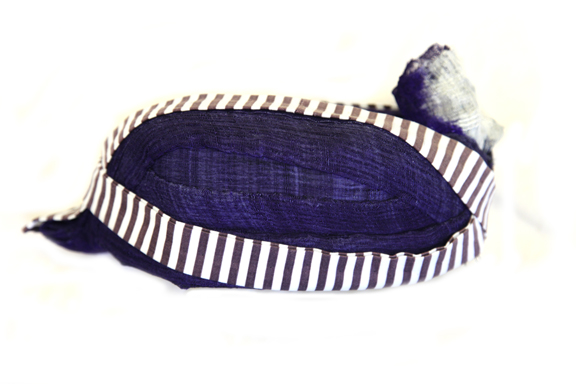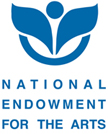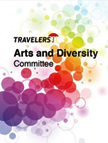Hmong Attire |
|
|---|
HA31: This piece is an embroidered apron with Hmong motifs. The thread used for the embroidery includes cotton threads. It is embroidered on a white monk cloth with cross stitches. Rickrack ribbon is used as a decoration. The motifs include mountains, quarter rickrack, and a house. The embroidery was sewn onto a synthetic fabric as appliqué. Two straps that are attached to the top of the apron are tied to the waist when the piece is worn.
By an unknown artist, 2000s, 65x20 cm Photo by Xai S. Lor, item at the Hmong Archives |
Back to Top |
HA32: This is a White Hmong woman’s apron, or sev, and features a style from the 1980s and 1990s. Due to the availability of new fabrics and threads, women used their embroidery skills and imagination to come up with different designs and motifs. This piece was done on monk’s cloth with green and pink cotton thread. Cross-stitch and appliqué methods were utilized, and pieces of commercial rickrack were used as decoration.
|
Back to Top |
 |
HA33: This piece of attire is called a sev, or apron. It is attached to a hlab sev, or sash, which is tied around the waist. The sev is usually worn on the front of the pleated skirt or pants and typically decorated either with appliqué, reverse appliqué, or embroidery work. In the center, a sun motif was done utilizing an appliqué technique with the fabric folded, cut, and sewn in overlapping fashion. The second sun motif was embroidered with cotton thread, using a padded stem, connected running, and chain stitches. The channels of the sev were constructed utilizing mountain cross-stitch embroidery motifs. The edges feature white, pink, yellow, and green appliqué mountain motifs, and the belt has step, star, and sun motifs. There are two unidentified motifs which appear similar to potted floral plants.
|
Back to Top |
 |
HA34: This Black Hmong women’s sev, or apron, is much wider than most White or Blue Hmong aprons. The top panel was sewn in cross-stitches on monk’s cloth in an appliqué style. The main motif involves an elaborate diamond with an embroidered fence and seed motifs. Two thin cloth straps were sewn onto the top panel to function as a belt. The lower panel was constructed of black cotton.
|
Back to Top |
|
HA35: This turban-style headdress uniquely belongs to the Hmong from Xieng Khouang, Laos. Traditionally, this headdress was not hand sewn together as a hat, easily put on and removed. It was a long piece of purple fabric, carefully wrapped around one’s head by another woman to make a turban. The siv ceeb, thin black and white striped cloth, was wrapped around the outer edge of the turban. Only in the late 1990s did Hmong women sew the fabric into a hat, and at this time they began to use many different fabrics, colors, and decorations. The art of wrapping the fabric into a turban is almost forgotten, as more and more young women adopt the hat. This has happened with many traditional Hmong headdresses being converted into hats.
By an unknown artist, 2000s, 30x14x15 cm |
Back to Top |
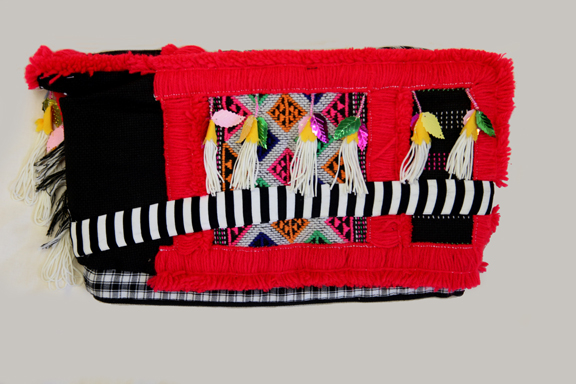 |
HA36: This piece is called a phuam paj, it refers to a flower headdress due to its bright colors. It is associated with the White Hmong. These headdresses were not developed until the late 1970’s. This style may have originated in Thailand. The red colors were probably influenced by the Hmong from Sayaboury Province, Laos, the siv ceeb (white and black striped band) is
By an unknown artist, 2004, 36x21x4 cm |
Back to Top |
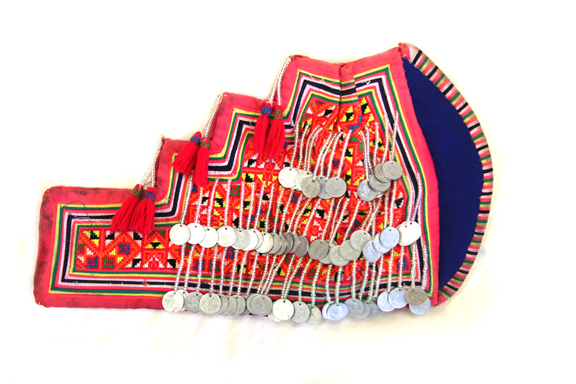 |
HA37: This is a Green Hmong headdress made for young girls and women. It is called a
By an unknown artist, 1980s, 35x20x1 cm |
Back to Top |
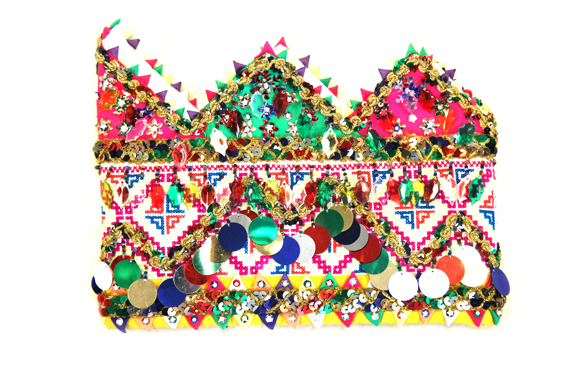 |
HA38: This hat is a variation of the rooster’s comb hat. It was also made in the 1980s by the Hmong people in the refugee camps. Some people refer to this style of hat as a “crown.” Such hats were worn for their ornamental effect. It is decorated with appliqué, cross-stitch
By an unknown artist, 1980s-1990s, 28x20x2 cm |
Back to Top |
 |
HA39: This is Hmong man’s hat. Typically, it is just black; however, this one has embroidery and reverse appliqué with an image that looks like a modified ram’s head, an upside down royal elephant head, or a Lao temple. Inside, tri-part snail chain stitches and fence motifs are included as embroidered embellishments. Ladder stitches were used to hold the reverse appliqué in place while the mountain appliqués were sewn on. At the top is a cotton knot.
By an unknown artist, 1980s, 20x40 cm in diameter |
Back to Top |
HA40: This Hmong men’s hat was made from synthetic fabric. Five or six triangle fabric shapes were cut and hand-sewn together to create the piece. A red knot was tied at the top of the hat as an embellishment, along with a Thai coin.
By an unknown artist, 2011, 24x53 cm in diameter |
Back to Top |
Page 1 << Page 2 << Page 3 << Page 4 >> Page 5 |
